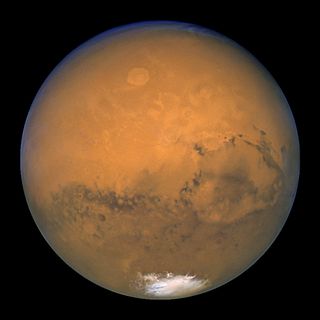Mars Makes Its Closest Approach to Earth Since 2003 Early Tuesday! Here's How to Watch

Mars will make its closest approach to Earth in 15 years early tomorrow morning (July 31), and you can follow the historic encounter live online.
The Griffith Observatory in Los Angeles will air a webcast about the celestial event, with expert commentary, from 1 a.m. EDT to 5 a.m. EDT (0500 to 0900 GMT; 10 p.m. to 2 a.m. local Pacific time). You can watch the show here at Space.com, courtesy of Griffith, or directly via the observatory.
You can see Mars with your own eyes before dawn on Tuesday (weather permitting) by looking to the southwestern sky. At about 4 a.m. your local time, Mars will be visible low on the southwestern horizon, with the moon shining to the upper left (as shown in the map below). [Mars at Opposition 2018: How to See It and What to Expect]

The Griffith Observatory is well-placed to host the Mars-viewing show.
"By a celestial coincidence, at the same time, Mars will be at its very best position for viewing through a telescope from Los Angeles, as it crosses the meridian and appears highest in the southern sky," observatory representatives wrote in a statement.
If you live in the Los Angeles area, you can also attend the Griffith event in person, for free. The observatory grounds will be open to the public, and small telescopes will be available for Mars viewing. (These scopes will be on the lawn; the observatory building itself will be closed.)
The moment of closest approach occurs at 3:45 a.m. EDT (0745 GMT), when Mars and Earth will be separated by just 35.8 million miles (57.6 million kilometers). The two planets haven't rubbed shoulders so tightly since August 2003, when they veered within 34.6 million miles (55.7 million km) of each other.
Get the Space.com Newsletter
Breaking space news, the latest updates on rocket launches, skywatching events and more!
That 2003 encounter was truly special — the closest between the neighbor planets in about 60,000 years. Indeed, it came within a cosmic hair of the Mars-to-Earth minimum distance, which is 33.9 million miles (54.6 million km). (The maximum separation of the two planets is about 249 million miles, or 401 million km, and the average distance between them is 140 million miles, or 225 million km.)
Tomorrow morning's close approach follows on the heels of Mars' "opposition." This milestone — when Mars, Earth and the sun align, with our planet in the middle — occurred Friday (July 27).
Mars has been noticeably brighter than usual in our skies for a while, as it's been getting closer and closer to Earth. But the Red Planet is nowhere near as big or as bright as the moon. So don't fall for that hoax, which keeps popping up despite persistent debunking efforts.
Follow Mike Wall on Twitter @michaeldwall and Google+. Follow us @Spacedotcom, Facebook or Google+. Originally published on Space.com.
Join our Space Forums to keep talking space on the latest missions, night sky and more! And if you have a news tip, correction or comment, let us know at: community@space.com.

Michael Wall is a Senior Space Writer with Space.com and joined the team in 2010. He primarily covers exoplanets, spaceflight and military space, but has been known to dabble in the space art beat. His book about the search for alien life, "Out There," was published on Nov. 13, 2018. Before becoming a science writer, Michael worked as a herpetologist and wildlife biologist. He has a Ph.D. in evolutionary biology from the University of Sydney, Australia, a bachelor's degree from the University of Arizona, and a graduate certificate in science writing from the University of California, Santa Cruz. To find out what his latest project is, you can follow Michael on Twitter.
